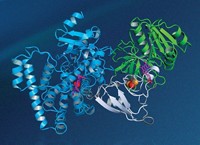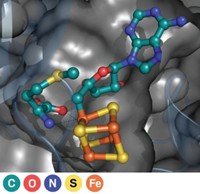Advertisement
Grab your lab coat. Let's get started
Welcome!
Welcome!
Create an account below to get 6 C&EN articles per month, receive newsletters and more - all free.
It seems this is your first time logging in online. Please enter the following information to continue.
As an ACS member you automatically get access to this site. All we need is few more details to create your reading experience.
Not you? Sign in with a different account.
Not you? Sign in with a different account.
ERROR 1
ERROR 1
ERROR 2
ERROR 2
ERROR 2
ERROR 2
ERROR 2
Password and Confirm password must match.
If you have an ACS member number, please enter it here so we can link this account to your membership. (optional)
ERROR 2
ACS values your privacy. By submitting your information, you are gaining access to C&EN and subscribing to our weekly newsletter. We use the information you provide to make your reading experience better, and we will never sell your data to third party members.
Synthesis
Nitrogenase Caught in Action
Intermediates in nitrogen fixation reaction are finally trapped
by Amanda Yarnell
October 17, 2005
| A version of this story appeared in
Volume 83, Issue 42

Enzymology
In nature, enzymes known as nitrogenases convert N2 found in the environment into a form that can be used to make amino acids and other biologically valuable nitrogen compounds. A multidisciplinary team has now trapped N2-derived intermediates bound to a nitrogenase. This long-awaited achievement, the researchers say, may open the door to understanding how these enzymes work.
The structure of nitrogenase and its active site has been known for more than a decade, notes spectroscopist Brian M. Hoffman of Northwestern University. A complex metal cofactor in the multisubunit enzyme reduces N2 to NH3. But this structural information told us nothing about how this enzyme is able to bind and reduce substrates, Hoffman points out.
For years, Hoffman has been working with biologist Dennis R. Dean of Virginia Tech and biochemist Lance C. Seefeldt of Utah State University to figure out how to trap and characterize nitrogenase intermediates that might shed light on the enzyme's mechanism. Now they've succeeded in trapping the enzyme with N2-derived intermediates bound to the active site (J. Am. Chem. Soc. 2005, 127, 14960). This is the break needed to get at the mechanism of this complex metalloenzyme, Seefeldt says.
Guided by their previous experiments with nonphysiological substrates, the researchers exposed subtly modified versions of the enzyme to N2 or one of two suspected dinitrogen intermediates and flash-froze the samples. Spectroscopy confirmed that they had indeed captured enzyme-bound intermediates.
The team is now carrying out more spectroscopic work to deduce the structure of the trapped enzyme-bound intermediates. That work should shed light on the most pressing questions about how nitrogenase works, including where N2 binds to the active site and how it is reduced, Hoffman says.





Join the conversation
Contact the reporter
Submit a Letter to the Editor for publication
Engage with us on Twitter